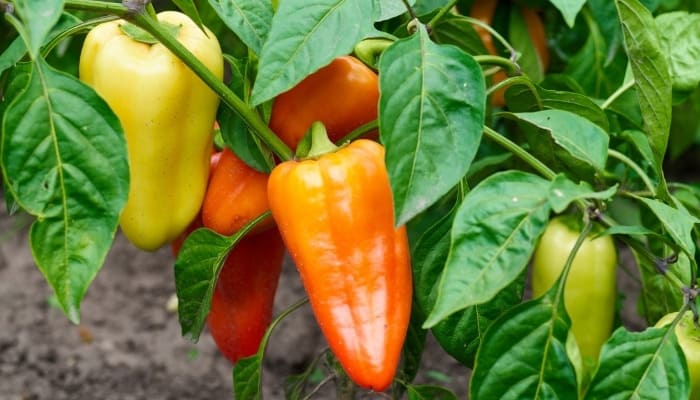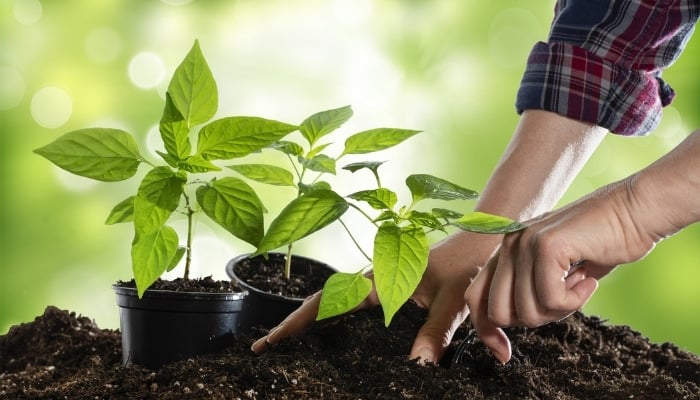There is a group of gardeners who strongly advocate for the advantages of using bone meal.
Others wouldn’t touch the stuff no matter what the benefits, but despite the smell and the potential bug infestation, bone meal is a good fertilizer that you can use in the garden.
Is bone meal good for pepper plants? With high levels of phosphorus and calcium, bone meal is a good food supplement for pepper plants. Phosphorus encourages more flowers, which translates into large yields. Phosphorus also protects the plants against diseases and infection and boosts healthy growth of the root system.
However, bone meal is considerably lacking when it comes to other essential nutrients, like potassium.
That means you should use it as a supplement and not a substitute for a well-balanced fertilizer. Read on to find out why bone meal is good for peppers and how to apply it.
Guide To Using Bone Meal for Peppers
Organic fertilizers are all the rage these days, and while bone meal is considered an organic fertilizer, you have to use it cautiously in the soil.
Pepper plants can benefit from this supplement but only when the soil is slightly acidic.
What Is Bone Meal Made Of?
Bone meal is the powder of crushed animal bones. After the bones are picked clean of any traces of fat, they are steamed to kill any bacteria in them.
The bones are left to dry before being crushed to make either powder or fine granules.
Why Use Bone Meal?
Bone meal is a good supplement that releases its high content of phosphorus and calcium into the soil to benefit the plants.
Many plants, especially those that flower, need phosphorus to bloom and produce fruits. Meanwhile, the calcium in the bone meal is a crucial element for the development of the walls of the cells.
Bone meal also contains negligible amounts of nitrogen, which plants need to grow stems and leaves. However, you shouldn’t rely on bone meal as the main source of nitrogen for the plants in the garden.
How Pepper Plants Will Benefit From Bone Meal
Pepper plants, like many veggies in your garden, need phosphorus in high doses in order to produce a good number of flowers.
Each one of these flowers after pollination will turn into a fruit. So adding bone meal to your pepper plant patch will help with the flowering and give you a good crop.
The calcium also boosts the growth of the leaves and stems and helps with fighting off diseases.
If the soil is impoverished, the trace amounts of nitrogen can come in handy to promote robust root ball growth.
Is Bone Meal a Complete Fertilizer for Pepper Plants?
Despite being labeled as an organic fertilizer, bone meal is far from being a complete plant food for your pepper plants or any other plants for that matter.
It has no potassium content at all, and the nitrogen content is so low, that your pepper plants will be stunted if you only use bone meal as the main fertilizer.
Is Bone Meal Good for Hot Pepper Plants?
Hot pepper plants need plenty of phosphorus and calcium to achieve the desired growth and expected yield.
Bone meal is an excellent source of those two nutrients, which makes it a good supplement for your hot peppers.
As a slow-release supplement, you don’t need to apply it more than once, and it will feed the pepper plants throughout their season until harvest time.
It also prevents such diseases as bloom end rot, which can damage your plants and reduce the crop considerably.
How To Use Bone Meal for Pepper Plants
You only need to apply bone meal for pepper plants once. Before sowing the seeds, check the soil to make sure it’s slightly acidic (try this 3-in-1 tester that also detects moisture and light levels).
Then sprinkle about 3 cups of bone meal for every 100 square feet of soil. Spread the bone meal thinly on the surface, and then use a rake to work it into the soil.
Break any clumps of bone meal in the soil to avoid attracting bugs and rodents to the garden.
Bone meal even in a powdery form is water insoluble. For the fertilizer to release its nutrients, it needs time and slightly acidic soil.
Water the soil thoroughly after planting the pepper plant seeds.

What Plants Like Bone Meal?
All plants that flower and thrive in slightly acidic soil will benefit from bone meal. Besides pepper and chili plants, you can safely use bone meal with carrots, onions, tomatoes, and radishes.
Flowering plants such as dahlias, roses, hydrangeas, lilies, and tulips also benefit highly from the phosphorus and calcium in bone meal.
How To Use Bone Meal in Potted Plants
If you prefer to grow your pepper plants in containers, you should bury the bone meal deep into the soil and not sprinkle it at the top as you would in a veggie patch.
Dig a hole in the middle of the soil, and add the bone meal. Then cover it with a thin layer of soil before planting the pepper seeds or seedlings.
This will prevent the smelly organic fertilizer from attracting pests to the pot.
Related Questions:
Do Pepper Plants Need Calcium?
Pepper plants need calcium through every stage of their lives. From developing stems and leaves to fruiting, calcium is an important nutrient that helps with strengthening the walls of the cells.
Without calcium, the pepper plant will have stunted growth, and the fruits will rot at the bottom.
How Is Bone Meal Made?
To make bone meal, the bones of animals, especially cattle, are processed. First, the bones are stripped of any traces of fat, and then steam cures the bones to kill any pathogens in them.
The bones are left to dry out completely before they’re crushed. Bone meal can either be powder or fine granules. It’s used as a food supplement for livestock as well as a fertilizer for plants.
Conclusion
You can safely add bone meal to the soil before planting your pepper seedlings. The slow-release fertilizer will feed the plants until they fruit.
Use bone meal as a plant food supplement and never as a substitute for a balanced fertilizer.

